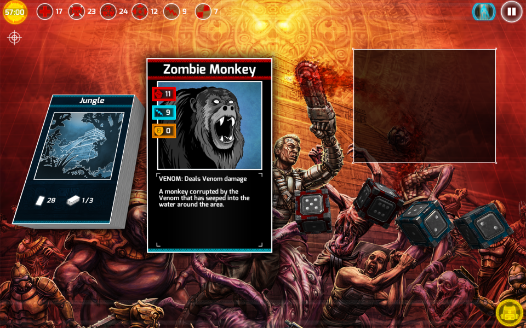The game features the same, familiar, card based exploratory mechanic as the original board game and digital conversion. You tool up your Warrior and send him out to destroy the BBEG. There are some nice improvements to the UI, the menu system is clean and functional, with a nice glowy-edged sci-fi feel. Retro-ists are going to miss Dave Andrews original card artwork from the boardgame, but the updated digital drawings are effectively grotesque and fun.
So what's new? Well firstly the setting, Chainsaw Warrior's (CWI) environment - a huge ruined municipal building in the center of New York expressing its dark vision of decaying Urban Modernity is gone. Instead Chainsaw Warrior II (CWII) airlifts us to an Aztecian Wilderness of Ancient ruins and steamy jungle. It's almost like an inverted trajectory of the Predator movies - the concrete jungle rambles in contrast with it's organic counterpoint.
 |
| Chainsaw Warrior 1 | Predator 2 | Urban |
 |
| Chainsaw Warrior 2 | Predator 1 | Jungle |
CW1 / CW2
Military Zombies / Primitive Zombies
Cyborgs / Animal Mutants
Tower Block / Ancient Temples
Chaos Cultists / Moon Cultists
Extraplanar Entities / Aztec Gods
Corpse looting / Air-drops
Corridors / Jungle
The sequel placed alongside the original surfaces a set core of semantic dualities, built environment / wilderness, modern / ancient, technology / nature, superstition / science.
There's another interesting parallel here, alongside generic Cartesian Dualities and the Predator franchise. Mentioned last time that Chainsaw Warriors designer Stephen Hand had been inspired by Peter Donelleys classic old school cavern-bash boardgame The Sorcerer's Cave. Sorcerer's Cave takes place in a labyrinthine cave produced by an evil wizard - a constructed, man-made environment. Donelly's second game, Mystic Wood, takes place, in an overgrown, natural, Arthurian Greenwood or, perhaps, in a more tangled forest...
 |
| Mystic Wood |
Mapping the Forest Shadow
In CWI enemies may be read as overcoming the physicality of the character taken to distorted, mostly man-machine, cyborg organism extremes. These exaggerated versions of CWs technologically augmented physicality, be they military zombies or metal-fused agents of chaos, trapped inside a steel and concrete edifice.
CWII is looking primarily at a natural world of wild vegetation, and over coming the internal nature of his mind, specifically this one:
| Triune Brain / MacLean |
It's Paul MacLean's brain. Well, not really his brain, but a diagram of his “Triune Brain” theory, popularised by Carl Sagan in the book Dragons of Eden. It basically maps Freuds Id, Ego and Super-ego on to a physical model of the brain based on evolution, breaks down something like this:
Reptilian Brain - basal ganglia - instinct, fight / flight responses
Paleonmamillian Brain - limbic system - emotions, social bonding, nurturing.
Neomamalian Brian - reasoning, intellect.
This model gained currency in popocculture markets (just ask Grant Morrison about Chaos Magic), but isn't exactly considered rigorous neuroanatomy or psychology - which you might consider as polite words for calling something debunked. But ultimately, one theory of mind is as good as any other (the map is not the territory, after all) so long as it illuminates the text, so let's stick a chainsaw in it and see what happens...
Journey through the Reptile Brain
 |
| Crocodile | Animals |
The Crocodile is most obviously symbolic of the reptilian, lizard brain - which at it's simplest drives the fight-or-flight responses. Indeed for most the game, CW must wade around in the lower-depths of his consciousness in response to his environment - it's the first option given to any encounter, fight or escape. CWII hacks into the reptilian level of consciousness, a dice rolling, card tapping, a meditation, not quite monotonous, the pitch and rhythm rises and falls as the player shifts through the deck. The lizard brain, with it's closeness to the central nervous system, controlling the autmotaic responses is also characterised with ritualistic and repetitive behaviors which is evoked by the reptilian symbols and fight/flight levels of interaction.
We can also consider the multifarious zombie-mutants as symbols of the reptilian level of consciousness, as they take on biological, natural aspects of reptiles - with their elongated crocodillian mouths, acid spitting and venomous bites, they are humanoids ("like us") who are redefined by their lizard-brain nature, unable to think beyond simple desire to kill or be killed, and in return the Chainsaw Warrior can only respond in these terms, a cold-blooded killer admists the cold blooded deadites.
In one odd example there is a mutant zombie with Spider - which whilst not fitting the triune brain model - there is no "arachnid" brain in MacLeans model, but nontheless it does serve to underline the bestial, animalistic nature of the enemies.
Paleomamillian Mechanical Animals
As we move up the evolutionary ladder out of the lizard infested swamp of prehistory, Chainsaw Warrior begins to interact with mammalian creatures, as symbols of the more complex parts of the brain.| Jaguar Warrior |
The mammalian brain, is most readily symbolized by The Jaguar, with its nurturing, play instinct. Critically CW often encounters the Jaguar as a parent, defending her cubs from his petrol-driven tree-cutter. In a recent update to the game, the CW can actually befriend a Jaguar and have it fight for him, again helping underline the bonding and parental behaviors that show the psychologyof paleomamillian psychology at work.
There are several other enemies that operate in "packs" preying in social groups or cultic cells, and CWs heavy weaponry is useful in removing them in one go, one successful blast from a flamethrower or rocket launcher can blast them all to hell. The herding instinct displayed by many of the animals and cultists directly contrasts CWs loner status and underlines the socialising characteristics of the mammalian brain as being abhorent to the single minded, sociopathic CW.
However, encountering pack animals also invokes strategic decision-making. Should CW spend limited resources by using heavy weapons, or expend time to remove them individually? CW is no longer able to rely on the simple, instinctive reptilian brain-work of fight or flight responses, but to make decisions based on the higher human faculties - logic and reason. Thus the paleomamillian stage of evolutionary conciousness provides a stepping stone to achieve 'strategic thinking.
 |
| Zombie Monkey | Overcome with reason |
As the seat of religion and faith is characterised as a function of the Mamillian Cortex, in MacLeans model, religion is little more than a form of social glue, designed to make one feel better about ones place in the world. In the world of Chainsaw Warrior, it appears religions and their cults are the result of supernatural beings power over nature - CWs ultimate mission is to defeat a supernatural evil who threatens the world.
 |
| Moon Cultists, thieving scumbags of the religious kind |
Supernatural Neomamillian Cortex
However, CW's mission to exert control over his subconscious animalistic instincts, and achieve rational mindfulness isn't all it appears to be.Once out of the first deck - the jungle, CW can occasionally discover and choose to enter abandoned shrines to ancient gods. If he does so, and succeeds in defeating the Guardian he can gain a 'blessing' - which will improve his chance of survival. The Guardians themselves are a tougher than normal opponent who will grind resources. It's a strategic decision, requiring logic and reasoning - the most evolved state of conciousness. That these encounters can only appear after the primeval jungles that characterises the earlier stages of the game, does reinforce a kind of evolutionary system at work.
One of the Temple Guardians is a beast that strongly resembles Ghodan from the Gamecube classic Zelda Windwaker (which I'm currently playing through with Little Zhu, so immediately came to mind.
 |
| Ghodan | Zelda" Wind Waker |
The Temples also give us of a Campbellian heroes journey where the protagonist must descend into the underworld, retrieve his 'boon' and return - itself influenced by Jungs alchemical model of psychological processes - delving into the subconscious to receive inspiration.
The expression of this mechanism - the temple - a site of archaic religion, posits that the CW delves down, not only into the earlier evolutionary stages of consciousness, but also cultural time. The delving into cultural spaces of the past in order to return empowered and enriched, is of course, metaphor par-excellence, almost the central, defining myth of the retro-gaming scene - the past is a foreign country, we like to kill it's inhabitants and steal it's stuff.
| AirDrop | CW joins the Cargo Cult |
In a similar vein to the helping of the ancient spirits in forgotten tombs, weapons caches are parachuted down, literally "gifts from above" randomly distributed gifts from unseen hands in the sky. CW1 just looted corpses, failed attempts at stopping the Darkness (or, perhaps, time-locked karmic bones files) The appearance of external aid, in the form of the spirits of the ancients and random military airdrops, makes the world of CW2 slightly less dark and unforgiving place than that of CW1.
Perhaps MacLeans model would remind us that the idea of aid from quasi-religious sources is naught but a form of superstitious paternalism, caused by our earlier evolution, which the cold logical strategic CW should seek to destroy in order to impose order upon his conciousness. Or perhaps CW2 seeks not just to repress the evolutionary stages of consciousness through acts of violence, but to reintegrate the positive elements of these stages of his neurology into a coherent whole, and ultimately bring all these aspects of his psychology into balance.
Our chainsaw wielding psycho can be read not just as a re-integrative evolutionary psychodrama, but also as a post-colonialist myth, symbol of The West - pillaging the culture and history of the exotic South for his own gain, deforesting vast tracts of rainforest with his trusty chainsaw, slaughtering wildlife and the superstitious, inhuman natives alike, stealing the lore of long forgotten gods without reverence, seeking only to use their power for his own ends. A technological aberration sent to destroy nature, magic and history in order to save his Imperialist masters orderly materialist view of the world against the animalistic incarnations of unreason, to steal the gold from the foreign gods and prevent night falling forever on the thin veneer of civilisation that CW is the product of.
Through the darkness of future's past...
On first playthrough I managed to meet the end of game boss monster - The Darkness - but had broken the one weapon required to destroy it, then subsequently failed to punch Darkness in the face, as one of the unlockable achievements suggests. The game is still difficult, but overall, the mood is more hopeful, upbeat, more positive than the doom-laden cybernetic death grind of CW1, if just as bloodthirsty.http://www.chainsawwarrior.net/



I thought that said "you tool up your Warrior and send him out to destroy the BBC" at first. That would have been a very different game.
ReplyDeleteThat's brill! Chainsaw Warrior: Tory Lords of Night. Can you privatise the nations assets in 24 hours, and save the nation from the Darkness of socialism?
ReplyDeleteHack away at the deficit with your buzzing blade of death! The funny thing is that's just the sort of satire GW may have done in the 80's.
DeleteCenters of spending represented by uniformed public service workers, hack away at zombie NHS nurses, skeletal police-force, and vampire librarians, all the while CWs equipment gets increasingly worse as military spending is cut.
DeleteCould also do a special Enoch Powel / UKIP edition: Chainsaw Warrior: The Rivers of Blood, but I fear far too many people would take it seriously.
It's a Kickstarter waiting to happen!
Delete